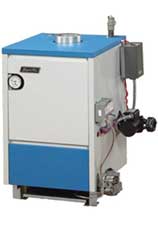 In essence, a boiler is a sealed vessel in which water or other fluid is heated. The vapor from this fluid leaves the boiler and is spread throughout your home as a heat source. Using a boiler is a way to transfer stored energy from the fuel source to the water in the boiler, and then to the rest of the house.
In essence, a boiler is a sealed vessel in which water or other fluid is heated. The vapor from this fluid leaves the boiler and is spread throughout your home as a heat source. Using a boiler is a way to transfer stored energy from the fuel source to the water in the boiler, and then to the rest of the house.
The heat source for a boiler is combustion fuels like wood, coal, or gas. Gas boilers heat water by using gas instead of wood or coal. An oil boiler uses oil or kerosene to heat. New boilers generally incorporate several new technologies to improve efficiency and performance. These same technologies can also be applied when retrofitting older boilers. The most important new technologies are as follows:
At their conception, boilers and furnaces relied on natural draft to move air. A draft hood limited condensation in the flue and ensured that the burner and flame were isolated from outside air pressure fluctuations. At the same time, this lowered the vapor pressure at which the flue gases would condense and cause damage to the flue. However, efficiency was lost because of the loss of heated interior air up the chimney.
Newer fan-assisted burners eliminated the draft hood and are better at mixing fuel and air. Fan-assisted burners also diminish losses by reducing the amount of hot air going up the chimney.
The fan also improves the heat transfer inside the boiler by improving combustion gas flow through the heat exchanger. Two types of fan-assisted systems are available: a forced system uses a fan to blow the fuel and air mixture into the boiler and an induced system that has the fan located at the outlet end of the heat exchanger passages.
Another improvement is the addition of motorized dampers. These stop heat from escaping up the chimney by automatically closing the flue when the boiler is idle. There is also an electric ignition. Older gas boilers have pilot flames that remain lit whether the boiler is firing or idle. Electric ignitions or other intermittent ignition devices eliminate this waste of fuel. A control circuit energizes the igniter and if the burner does not fire on the first try, the igniter re-fires until the burner is lit.
Lastly, there is sealed combustion and pulse combustion. Sealed combustion controls the process more carefully by preventing boilers from infiltrating into the building. In a sealed combustion boiler, air is drawn directly from outside through a sealed venting system, ensuring that heated indoor air is not mixed with the outside air during the combustion process. Instead of a continuous flame, pulse systems create discrete, rapid combustion pulses in a sealed chamber. This intensely turbulent process results in a highly efficient heat transfer to the heat exchanger and allows for flue gas condensation in condensing boilers.
